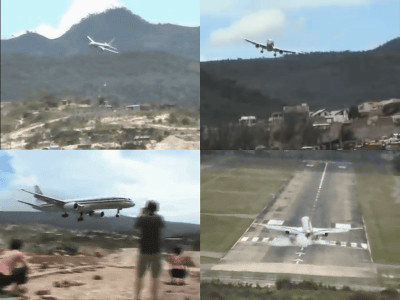It turned out that the Boeing 737 aircraft was causing a contact with the aircraft due to "Illegal input to the iPad"

ByKurt Clifford
On August 1, 2014, the Boeing 737 aircraft operated by Qantas, Australia, rubs the rear of the aircraft against the runway during takeoff runsTail strike"It caused an accident called. When authorities investigated this accident, the cause wasBecause I entered numerical values incorrectly when entering the numerical value of the aircraft to iPad's applicationIt is proved to be.
Qantas 737 "tailstrike" was caused by iPad data entry fail | Ars Technica UK
http://arstechnica.co.uk/gadgets/2015/11/qantas-737-tailstrike-was-caused-by-ipad-data-entry-fail/
The tail strike is caused by Qantas Airlines of Australia operated by Boeing 737-838 aircraft (Aircraft registration number: VH - VZR). When I took off from Sydney airport on August 1, 2014, the pilot took the operation to pull the nose and as the plane did not reach sufficient speed for takeoff, the aircraft had an angle too much and the aircraft's tail I touched the runway. The aircraft continued running even afterwards, took off, and continued flying without problems to Darwin, the destination, safely landing.
The Australian Traffic Safety Authority who conducted the cause investigation after the occurrence of the accident announced the investigation report. Among them, I conclude that the cause of the accident was that the first officer entered an erroneous numerical value when entering the weight of the aircraft to the iPad. The first officer who operated it has revealed that he entered "76, 400 kg" by mistake as "66, 400 kg" and input as much as 10 tons.
(PDF)Data entry error and tailstrike involving Boeing 737-838 VH VZR - ao - 2014 - 162 _ final. Pdf

◆ The till the accident happens
In the report, the Traffic Safety Authority concludes that the two accidents occurred "independently and inadvertently" caused the accident this time.
The first mistake occurred during the weight calculations carried out by the captain. Prior to takeoff, the captain said that the aircraft weight which does not include fuel is "No fuel weight(ZFW) ", I calculated the take-off weight (TOW) by recording the weight of fuel loaded on the aircraft on paper notes, but from that numerical value of fuel weight"1Because the letters of "missed", the take-off weight is 10,000 kg (10 tons) lighter than the correct numerical value66,400 kgI was struck out. Afterwards, this number was taken in the captain 's iPad "Onboard performance tool"(OPT) is entered by the co-pilot, resulting in erroneous flickering of the speed and engine power required for takeoff.
The onboard performance tool using the iPad is one of the traveling tools provided by Boeing, which can calculate the optimum speed, the engine with various weather conditions, runway easily and can operate optimally . Qantas was promoting the introduction of this tool from 2012.
Boeing provides Qantas with performance tools by iPad | FlyTeam news
http://flyteam.jp/news/article/14409
The second event occurred when the first officer entered take-off weight into OPT. Despite calculating the takeoff weight correctly as 76,400 kg in the same calculations he did, the first officer had entered the wrong numerical value of 66,400 kg for OPT. The report says that this is due to "transposition error" that can occur when entering numerical values into the equipment. A transition error is a type of mistake that makes a mistake in neighboring numerical values when a numerical value is voiced or written down. In the case of this accident, in the case of this accident, "6" which is adjacent to the place to be entered I entered it.
In the report, as these two mistakes occurred individually and continuously, the speed and engine power required for takeoff were calculated much lower than the actual figures, and lift required for takeoff was obtained I conclude that tail strikes were caused by not being there.
The appearance that the screen of OPT was reproduced is like this. This screen is a screen where incorrect numerical values are entered, and Takeoff Weight is "66400 KG"At the bottom of the screen is the speed at which you start napping and enter takeoff posture"VR"But"146 KT"(Knot: about 270 km / h), and the thrust required for takeoff is"88.4(%) "Is displayed. Also, it is known that there is a mistake in the input of the outside air temperature, and the wrong value such as "51 C" (51 degrees centigrade) was originally entered as "35 C" to be entered.

The state of the correct screen display is here. If the aircraft's weight is "76400 KG"VR speed when correctly input is"157 KT"(About 290 km / h), the required engine thrust is"93.1(%) ", And it is understood that the numerical value calculated incorrectly became much lower than the actual numerical value.

In the report, the item of weight of the aircraft is taken up as the main item, but input error of the outside temperature also affects the calculated figures to a considerable extent. Generally, the higher the air temperature, the lower the air density, so it is necessary to increase the output of the engine.
◆ Qantas Airlines' Response After the Accident
After the accident, Qantas has taken measures to improve the procedure before checking and to prevent similar mistakes. In the current procedure, after the pilot and the first officer have calculated them separately, it is said that a procedure to verify that the takeoff speed is correct by referring to the reference manual of the aircraft is adopted.

ByJerry
Related Posts:







